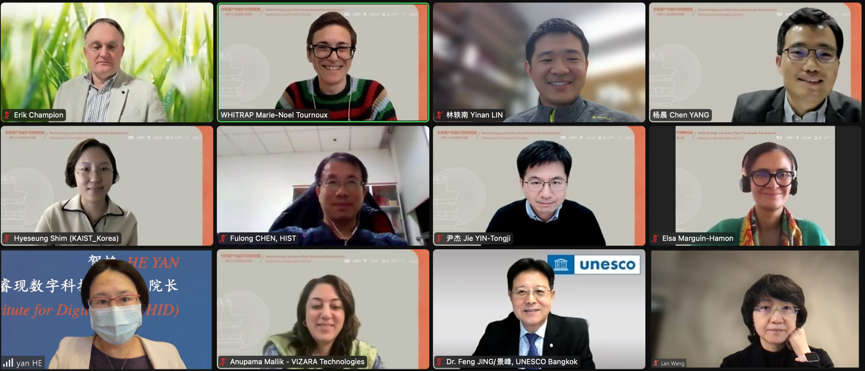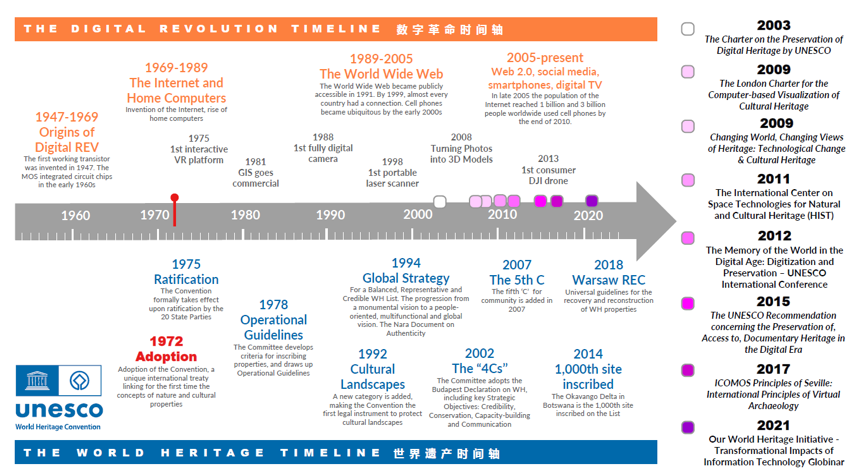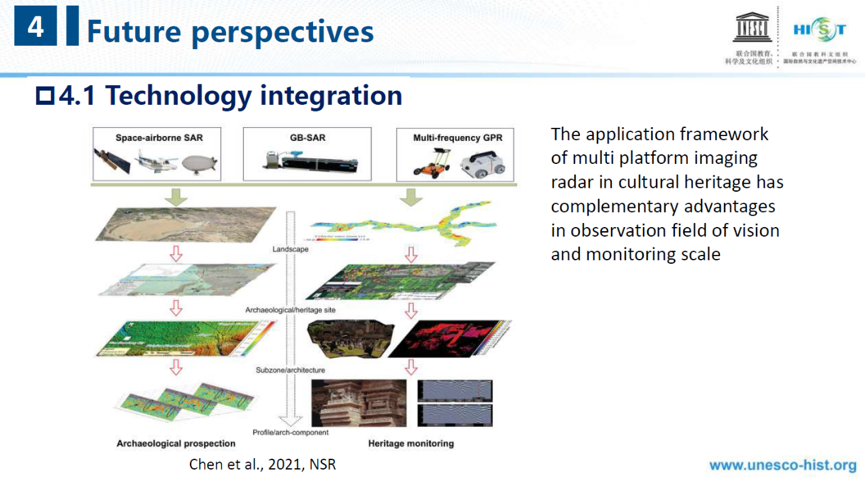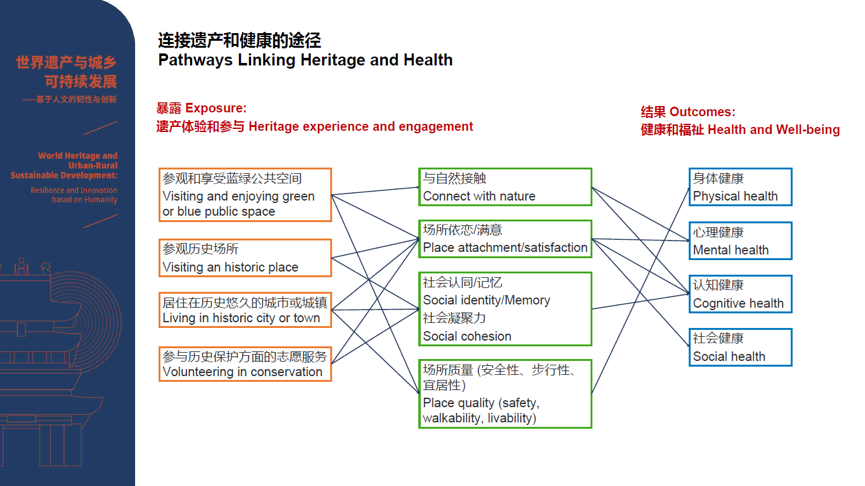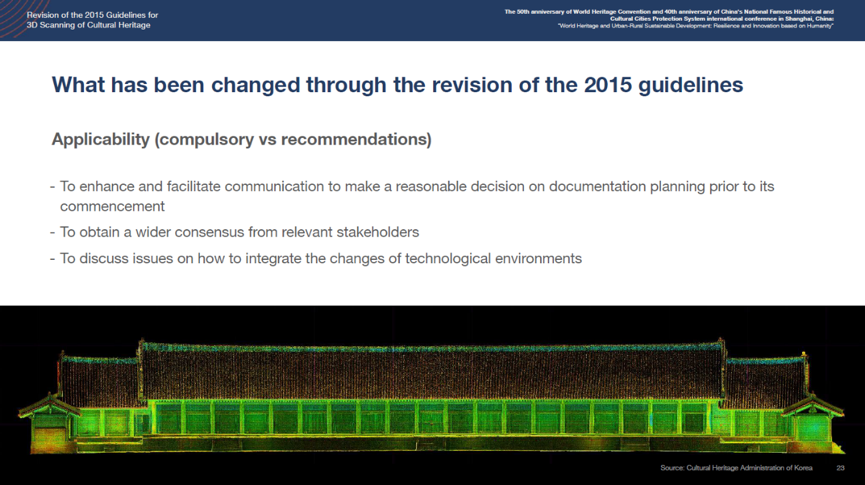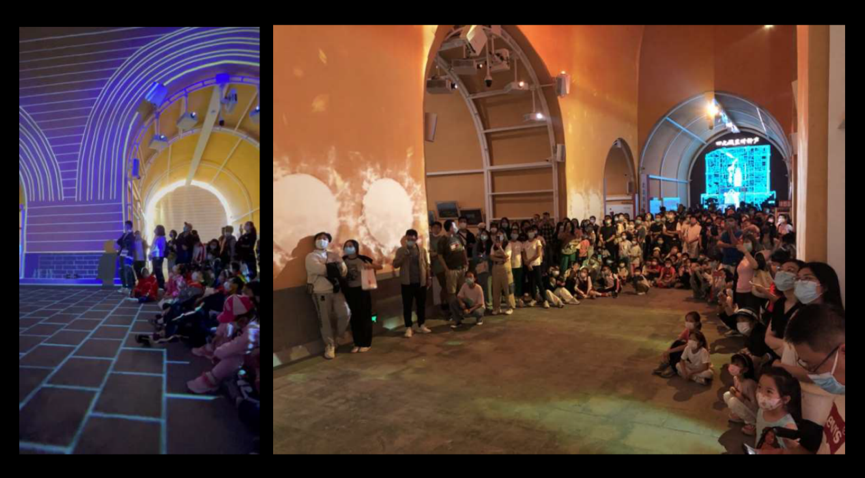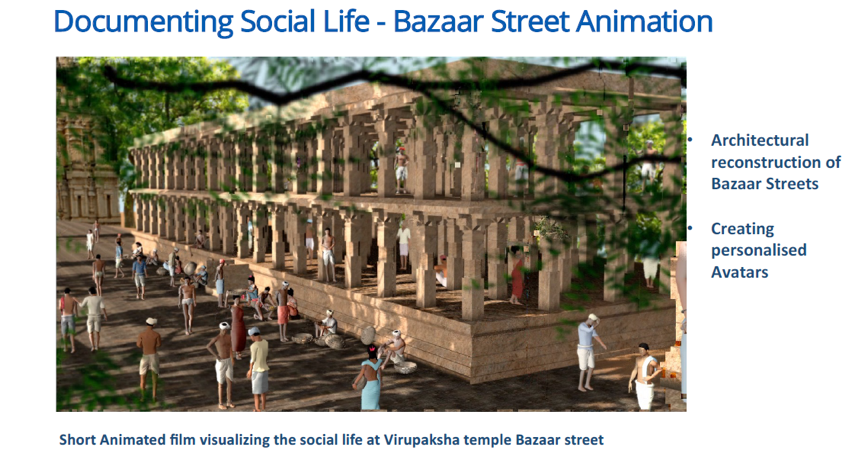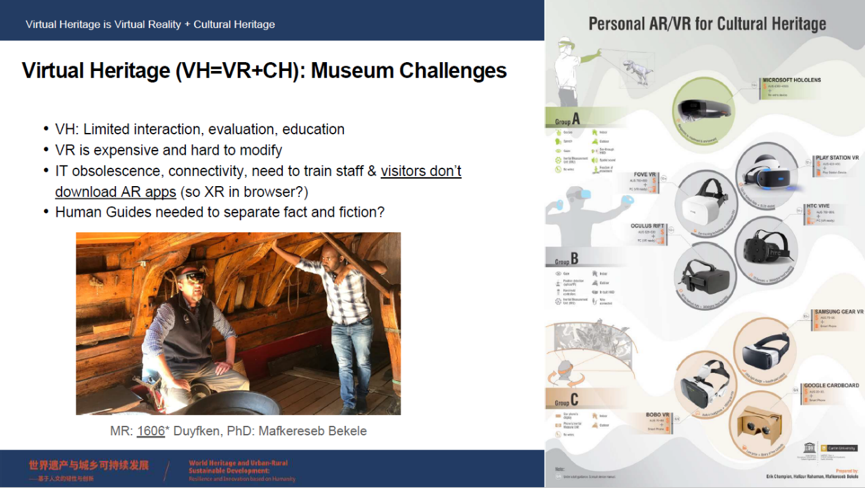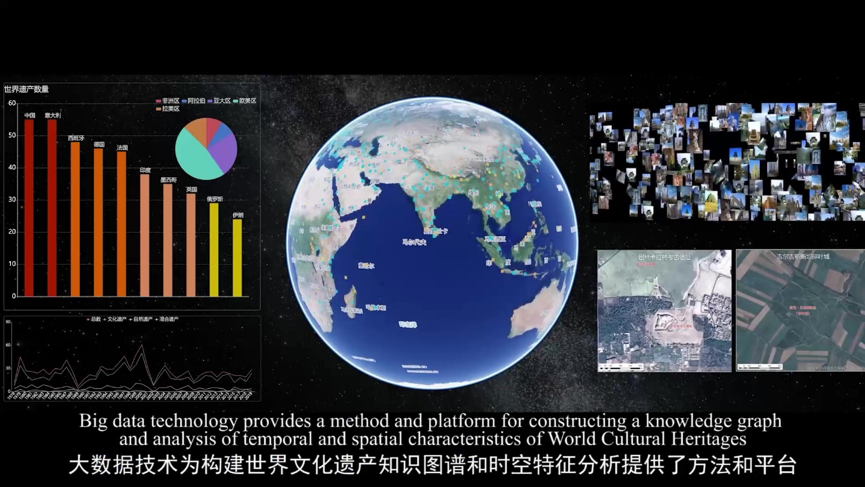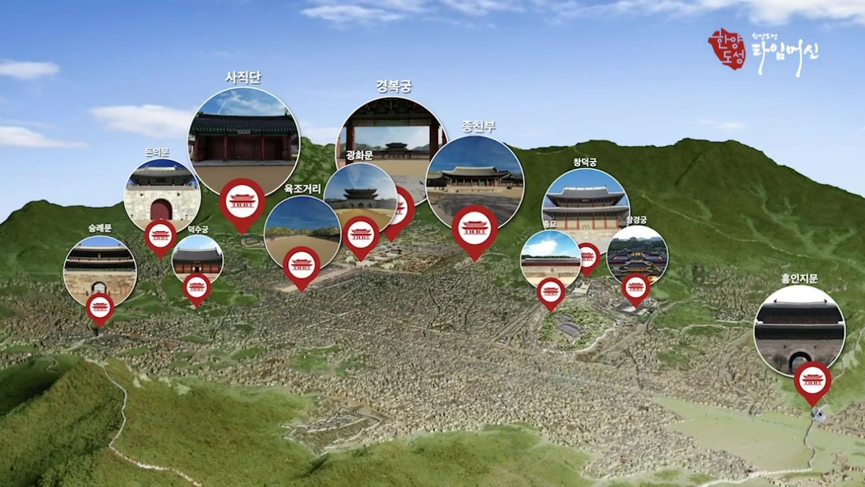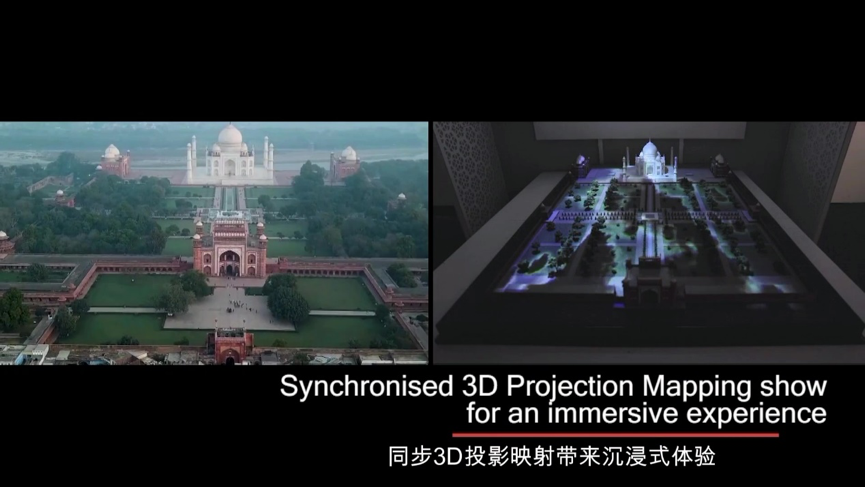| Highlights of Topic 4 at the Conference |
| PublishDate:2022-12-15 Hits:1667 |
Digital conservation is currently one of the most discussed issues in the field of World Heritage research and practice. At this important historical moment of the 50th anniversary of the World Heritage Convention, the aim of this session is to improve the scientific system of heritage conservation and realizing sustainable development of urban and rural areas and World Heritage. Thus, this session is focusing on reviewing the history and the key issues of the digital conservation of World Heritage, interpreting the new vision brought by digital technologies, and looking ahead to the opportunities and challenges of digital conservation in the next 50 years.
The session was co-chaired by Associate Prof. YANG Chen, College of Architecture and Urban Planning, Tongji University, and Hyeseung SHIM, Researcher from Digital Heritage Lab of Graduate School of Culture Technology, Korea Advanced Institute of Science and Technology.
Five experts were invited to give presentations.
The discussion was joined by three guests, Elsa Marquin-Hamon, Director of Research and International Relations of the Ecole Nationale des Chartes, France, Dr. LIN Yinan, Associate Professor at College of Arts and Medin, East China University of Science and Technology, and Marie-Noel TOURNOUX, Project Director of WHITRAP Shanghai.
Group photo © LUO Xi
1. Topic Introduction
Prof. YANG Chen first gave an overall introduction to the topic by systematically reviewing the relationship between the digital revolution and World Heritage conservation, interpreting the achievements and major events in digital conservation of World Heritage since 1972, and explaining the new visions and technologies of heritage conservation in four dimensions: Recording & documentation, monitoring& management, interpretation & presentation, and international collaboration & capacity-building.
Prof. YANG argued that digital technologies enabled us to look at natural and cultural heritage with an unprecedented perspective, precision, and breadth, changed the way we access, share, and disseminate heritage information, contributed to the innovation of the way heritage knowledge is produced, and promoted the global recognition of the World Heritage. Digital technologies have played an important role in supporting World Heritage conservation and sustainable urban and rural development, and have expanded the concept of heritage and the scope of conservation research.
Prof. YANG also identified eight challenges for digital conservation of heritage in the digital era, including protection of digital archives, duplication of efforts, evaluation standards of digital conservation, rapid outdate of technologies, limited funding, inadequate capacity-building, ethical issues, and marginalized groups created by technology. In conclusion, Prof. YANG called on all heritage conservationists to collaborate in promoting the development of World Heritage conservation from technological innovation to conservation system upgrade in the next 50 years. The digital revolution and the World Heritage Convention © YANG Chen
2. Thematic Presentation
Prof. CHEN Fulong, in his presentation “Methodology and Practice of Remote Sensing for Cultural Heritage”, pointed out that, as a new driving force for sustainable social development, cultural heritage carries the memory of human history and civilization, contains archaeological and cultural values, and is the basis for the development of green tourism in the new era. SDGs 11.4 of the UN 2030Agenda for Sustainable Development called for “strengthen efforts to protect and safeguard the world’s cultural and natural heritage”. From the concept and significance of remote sensing and cultural heritage, Prof. CHEN presented the challenges and scientific issues in the interdisciplinary research of remote sensing and cultural heritage, introduced the methodologies of imperceptible archaeological traces enhancement using wide-area remote sensing and dynamic monitoring of heritage environmental factors, sites, and monuments, and assessed the applicability and potential of the technical methods in application scenarios.
Prof. CHEN then shared three pilot application cases of remote sensing archaeology, heritage monitoring and SDGs indicators assessment in two dimensions, namely “remote sensing archaeology and civilization evolution" and "heritage monitoring and sustainable assessment", demonstrating the potential and capability of remote sensing big data and scientific discovery in serving UN SDGs 11.4. Prof. CHEN finally gave an outlook on the future of remote sensing for cultural heritage in terms of technology integration, interdisciplinary studies, and multilateral cooperation. The integration of remote sensing technologies supporting multi-scale monitoring and analysis of cultural Heritage © CHEN Fulong
Prof. WANG Lan and Dr. YIN Jie demonstrated the role of history and heritage in supporting urban development from the perspective of health in their presentation “Linking Heritage and Health: How Historic Places Affect Human Health and Wellbeing”.
Based on the concept of "Healthy City" proposed by WHO and "Good Health and Well-being" emphasized by SDGs 3, they reviewed the focus on health in historic urban planning, and pointed out that heritage experiences and engagement can be an important way to achieve health and well-being. Then they suggested four pathways linking heritage and health, including promoting mental and physical health through harmonious blue-green spaces and urban environments in historic places; improving neighborhood qualities, place satisfaction and pro-social behavior; strengthening social integration, social networks, and support; and supporting mental health using heritage-based digital technologies. At the end, they shared their research explorations on health-oriented urban regeneration of industrial heritage. Pathways linking heritage and health, WANG Lan © YIN Jie
Hyeseung Shim's presentation was entitled “The Standardization of Three-Dimensional Documentation of Cultural Heritage and Beyond: Ongoing Efforts and Visions in Korea”. For heritage conservation, fast-developing 3D data recording techniques have emerged as a major way of documenting cultural heritage in Korea. Accordingly, standardization of 3D data has become an important issue in order to enhance the data quality and ensure its sustainability for utilization. Therefore, we (KAIST) were commissioned by the Cultural Heritage Administration of Korea (CHA) to launch the revision of the standardization guidelines for 3Ddocumentation of cultural heritage – from the acquisition and processing of data to the delivery of results – and publish the revised version. In my presentation, I will be able to share the main issues and challenges in the process of publishing the revised guidelines in Korea. This revision project has also paved the path forward for the CHA to enlarge the established database of state-designated sites and artefacts (including the world heritage of Korea), grow various digital heritage initiatives and establish relevant policies for setting up the smart conservation system. The changes brought by 3Drecording technologies to cultural heritage documentation © Hyeseung Shim
HE Yan's presentation was entitled “Beijing's Central Axis: Digital Presentation and Social Sharing”. The Beijing Central Axis has a long history and has been an important witness to the development process of the city. The presentation elaborated on the presentation and interpretation strategies based on the World Heritage conservation criteria. The Central Axis exhibition integrates the Central Axis with scattered thematic museums, combines heritage site displays and community-based exhibition galleries, and merges online and offline digital presentation to establish a complete interpretation system.
HE Yan also introduced how the presentation of Beijing’s Central Axis strengthen the effectiveness of value interpretation to the public using digital display techniques such as immersive films, interactive devices, acoustic simulation, based on Bell and Drum heritage building and community-based exhibition galleries. Public participation was promoted in various means, combining comprehensively application of digital display techniques such as mobile immersive time capsule and online exhibition, together with community engagement activities including co-curatorship, public archiving, and educational tour.
HE Yan summed up the presentation by emphasizing that in conservation and interpretation of the heritage, the Central Axis should not be treated as a relic of the past in isolation. Our work should focus on integrating heritage values into the contemporary urban spatial experience, demonstrating the symbiosis of heritage and people. The immersive film of the conservation of the Bell and Drum heritage building © HE Yan
Dr. Anupama Malik's presentation was entitled “Digital Innovation in India for Immortalizing Heritage”. She began with an introduction to the history and heritage values of Hampi, a World Heritage Site in India, and shared India’s developing process and achievements in digital heritage conservation. She introduced the use of digital technologies such as photogrammetry, laser scanning, digital restoration and analysis, 3D modelling and mixed reality, as well as the introduction of virtual museums, games, and virtual goods in future heritage conservation projects from four aspects: Modeling and representing tangible heritage, analysis, and digital restoration of artefacts, archiving intangibles and explorations with Digital Hampi project. Visualizing social life by animated film © Anupama Mallik
Prof. Erik Champion's presentation was entitled “World Heritage 3D Models and Gamification in an Emerging Metaverse”. Virtual Heritage (VH) is the combination of virtual reality and cultural heritage. The application of virtual heritage faces many challenges—the rapid rate of technology obsolescence, limitation in connectivity and high price.
Aiming at addressing issues such as the wide variety of data formats and frequent updates of 3D models, the lack of reference to 3Dmodels in academic research, and the inability of existing 3D model platforms to meet the needs of virtual heritage, he shared his experiences and current achievements in developing open-access workflows from real world to AR and MR, open data platform for 3D and GIS, and game templates for museum multimedia.
Prof. Champion pointed out that virtual realities need to express “cultural presence”,i.e., the meaning and significance of a place, or object to people in the past, and suggests the possibility of using mixed reality technologies to enable co-learning with different cultural perspectives, to promote heritage learning in game design and playtesting, and to integrate heritage and metaverse. Virtual heritage and the challenges © Eric Champion
3. Project Demonstration
The session also collected three representative cases of digital heritage protection from different countries, presenting the latest achievements of the application of digital technology in different scales, different heritage objects and different cultural backgrounds. The demonstrated projects included the Big Earth Data Serves China’s World Heritage from the HIST, the Hanyangdoseong Time Machine Project from Cultural Heritage Administration of Korea, and the AR, VR, AI based Interactions for the Taj Mahal World Heritage from the VIZARA Technologies Pvt Ltd. The Big earth data assisting the conservation of World Cultural Heritage © HIST
The Hanyangdoseong Time Machine Project © Cultural Heritage Administration of Korea
The AR, VR, AI based interactions for the Taj Mahal World Heritage © VIZARA
4. Discussion
In response to the current key issues of digital heritage preservation, the guests had an in-depth discussion around the objectives and directions of digital heritage activities for the next 50 years. Elsa Marquin-Hamon, Director of Research and International Relations of the Ecole Nationale des Chartes, stressed the importance of digital document conservation based on her research and practice. She suggested that the preservation of documentary heritage, the digitization of documents and building digital museums and libraries not only provide valuable resources for researchers, but also have a multi-dimensional value in terms of education, technology and interactive data reproduction. The use of digital technologies such as text recognition, algorithms and artificial intelligence for text mining and document restoration can help us to better understand heritage. It is in the common interest of heritage conservationists to improve the capability of heritage conservation and linking past, present and future.
Prof. LIN Yinan pointed out that interdisciplinary collaboration breaks down previous technological limitations and offers new opportunities. Digital technology allows us to understand the historical way of life and disseminate and inherit heritage knowledge in a better way. We need to look beyond the inherent perceptions of researchers to achieve a meeting of minds between researchers and the public, which is a direction that needs to be explored in the future. He then shared his progress of work on the study of the traces and interpersonal networks of foreign residents in Fuzhou, through the interpretation of historical photographs by face recognition technology. He pointed out that the introduction of new technologies has helped to reveal the relationship between people and heritage, enabling heritage conservation to move from the recording and analysis of material heritage to the recovery of the historical, cultural and social scenes behind it.
At the end of the discussion, the chair, Prof. YANG Chen invited the guests to summarize their vision of the key to digital conservation in the next 50 years in one-sentence.
Yin Jie: Heritage is a legacy of history, and digitalization of heritage can provide us with a platform, tools and resources to study the interrelationship between heritage and health, and we are keen to engage in this aspect of research.
Anupama Malik: The main issue would be how could we collaborate, meet and talk more often. All of us are working in our own field and making efforts, but how could we actually have one platform or forum to see what is being done by each other, collaborate and work together, keep doing what we are doing in the past 50 years while keeping up with international academic and industrial trends.
CHEN Fulong: The most important thing is to bring technological transformation into practical exercises, and to better promote the widely application of digital technologies by various stakeholders.
Hyeseung Shim: We have been talking about benefits generated by technology innovation a lot, but in this context, it’s very important to know how to appropriately use these technologies for conservation. In order to doing so, I think it’s time to think about ethical principles of handling and storing data, and set up a clear guidance of documentation in the following 50 years.
Erik Champion: In the next 50 years, heritage is not so much a technological showcase alone, but a continuous dialogue with the audience as co-partner. So, rather than just create data and skill, we need to have shared meanings and pass them down through generations because that’s the basis of cultural heritage.
Elsa Marquin-Hamon: We need to continue our existing work. Using the concept of data mining in cultural heritage, to make our heritage more accessible, interoperable and reusable. Moreover, we need to remember that heritage conservation is not only about technology, but also a problem about organization and common places.
LIN Yinan: The transmission process of our heritage values needs to go beyond the material and touch on the people themselves.
YANG Chen: Advanced technology does not mean successful conservation, and one should see what is really required and do only what is necessary.
5. Wrap Up
Project Director of WHITRAP Shanghai, Marie-Noel TOURNOUX summarized the session by pointing out that the forum has carried out multi-level sharing and discussion on new technologies and new vision of heritage protection, with the following three main achievements:
1. New technologies and the WH Convention are twins, who developed in parallel and interact with each other throughout the history. New technologies are supporting the implementation of World Heritage Convention and impacting our understandings of heritage types and the way of conservation.
2. New technologies provided us with unprecedented access to data, deepening and enriching our understanding of heritage at all scales and all types of study area, developing new study are as such as health and global heritage observation. With new technologies, we can better monitor and manage heritage, include data and research as baseline information in legal instruments and guidelines, and develop the significance and types of heritage.
3. New technologies allow us to develop new approached to interpret and share knowledge, emphasizing the interaction between different sectors and actors. Meanwhile, we should also be aware of the limitation and potential problems of digital technologies, including local capacity building, information accessibility and data vulnerability.
Contributed by YANG Chen& CHEN Zhiyu Typest by ZHANG Yuzhuo(Intern)& JI Zhenjiang(Intern)
|
- News | WHITRAP Shanghai and CNR-ISPC bilateral meeting
- News | WHITRAP meets Cité de l’Architecture et du Patrimoine
- WHITRAP Hosting "Workshop on Preliminary Assessment for National Focal Points of the Asia Region" in Chengdu
- WHITRAP Shanghai meets UNESCO
- INTERNATIONAL CONFERENCE PRELIMINARY ANNOUNCEMENT & CALL FOR PAPERS
- Observation of the 46th Session of the World Heritage Committee
Copyright © 2009-2012 World Heritage Institute of Training and Research-Asia and Pacific (shanghai)


